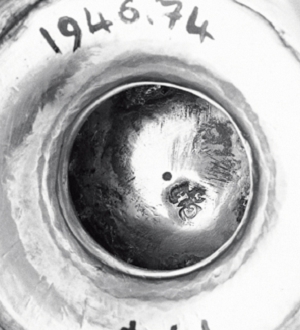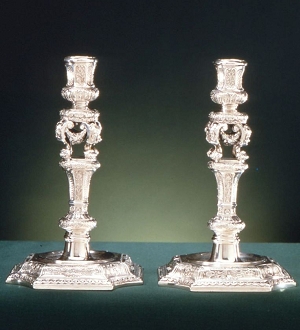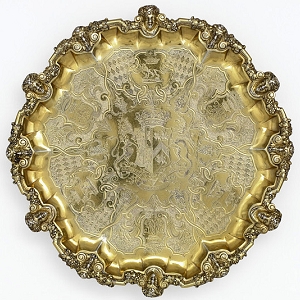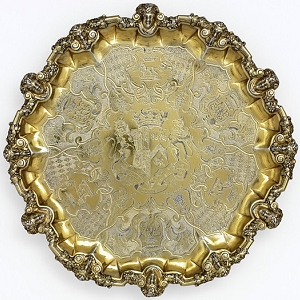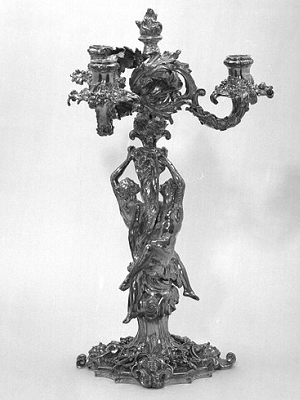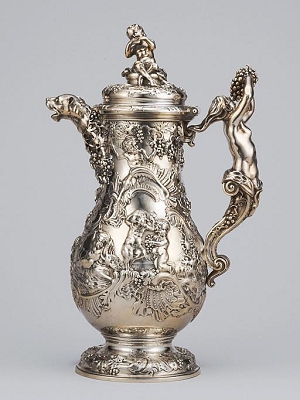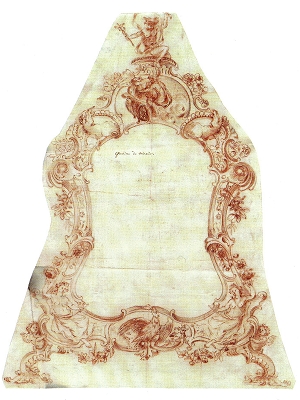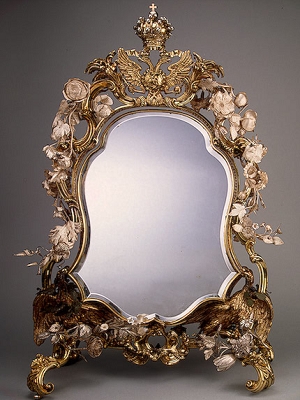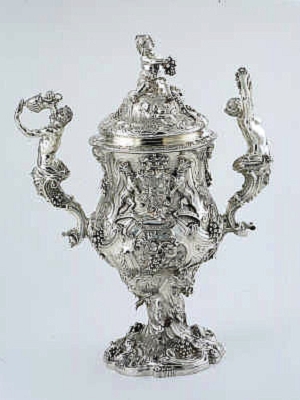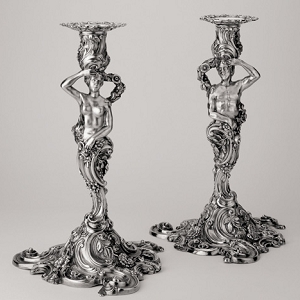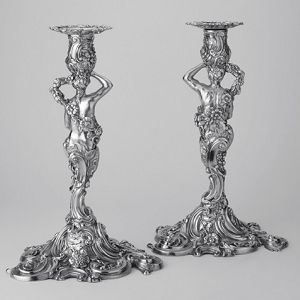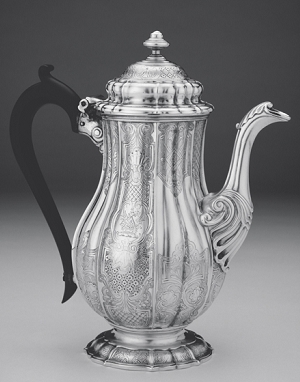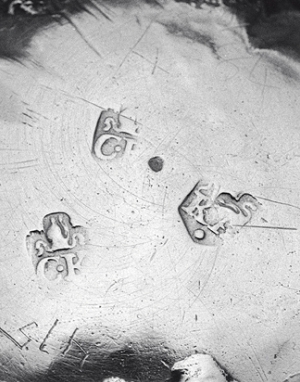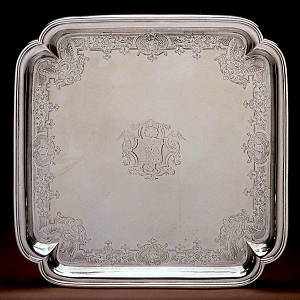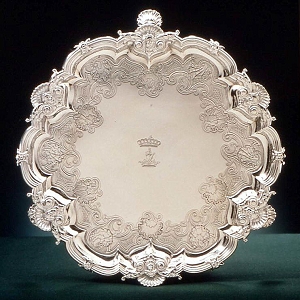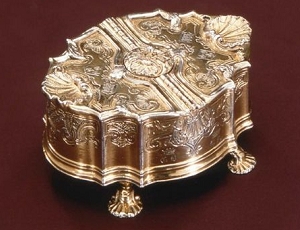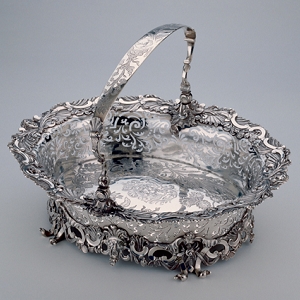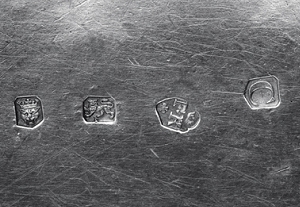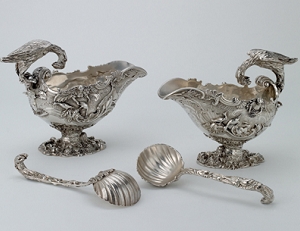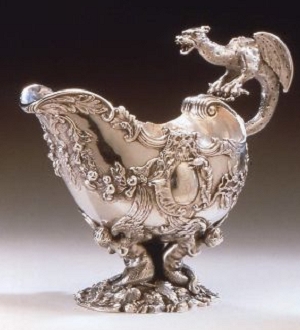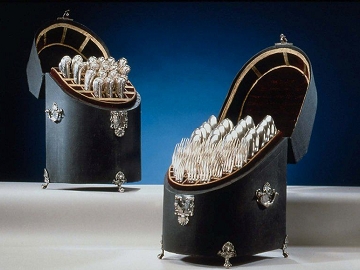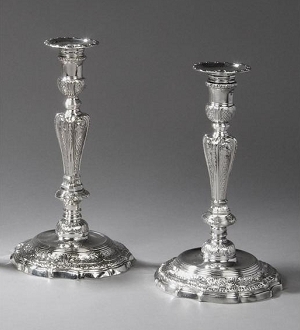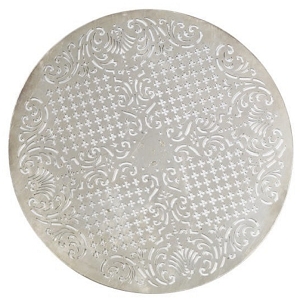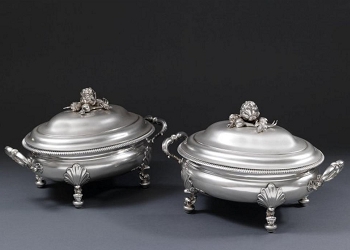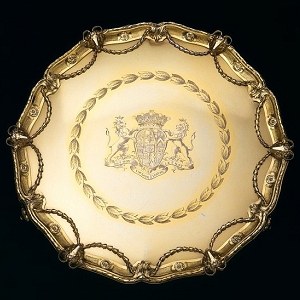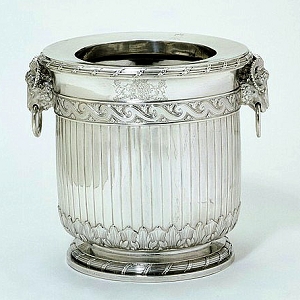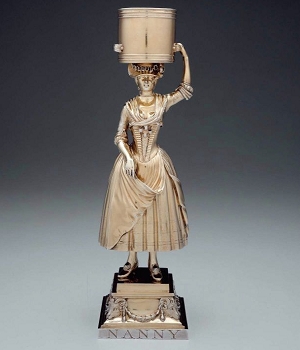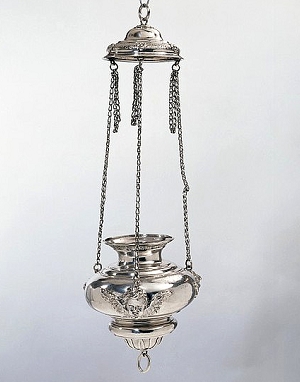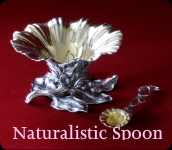Charles Frederick Kandler (I), active 1727-1750
Charles Kandler's life and career are certainly an enigma. It has been suggested by several commentators that there were in fact two or three Kandlers, owing to the fact that a variety of marks were listed sequentially under the names of;
- Charles Kandler (active 1727-1750) - Charles Frederick Chandler (I)
- Frederick Kandler (active 1739 until 1776) - Charles Frederick Chandler (II)
- Charles Frederick Kandler (active 1775-1793) - Charles Frederick Chandler (III)
Moreover, all three of these names were registered at the same address at St. James's continuously from 1735 to 1793. It is possible, and indeed likely, that the marks were used by at least 3 goldsmiths, perhaps a father, son (or nephew) and grandson.
Biography
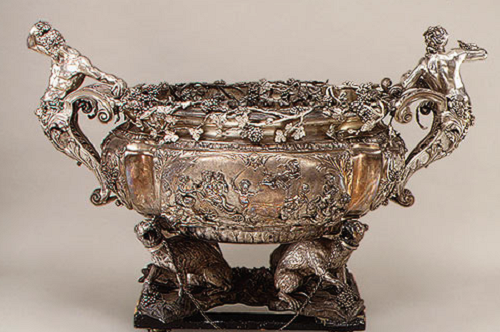 Wine Cistern by Charles Frederick Kandler, 1734. This was made for the Westminster Bridge Lottery however someone (probably Paul de Lamerie) sold it to Catherine the Great, Tzar of Russia, and it remains in the Hermitage Museum, the largest extant piece of antique solid silver in the world. It is a huge folly, and a beautiful one: utterly dispensable yet extraordinary. In 1734 Paul de Lamerie was called on to produce his two great Chandeliers in the Kremlin. "No record of apprenticeship or freedom. The identity of this highly important maker remains a baffing mystery." said Arthur G. Grimwade in his book 'London Goldsmithss 1697-1837 Their Marks & Lives'. "The late Norman Penzer, when working on the subject of the great wine cistern by Kandler in the Hermitage, made considerable effort to uncover any clue to his origin but without success." Today we can know a little bit more but he is still deep enigma.
Wine Cistern by Charles Frederick Kandler, 1734. This was made for the Westminster Bridge Lottery however someone (probably Paul de Lamerie) sold it to Catherine the Great, Tzar of Russia, and it remains in the Hermitage Museum, the largest extant piece of antique solid silver in the world. It is a huge folly, and a beautiful one: utterly dispensable yet extraordinary. In 1734 Paul de Lamerie was called on to produce his two great Chandeliers in the Kremlin. "No record of apprenticeship or freedom. The identity of this highly important maker remains a baffing mystery." said Arthur G. Grimwade in his book 'London Goldsmithss 1697-1837 Their Marks & Lives'. "The late Norman Penzer, when working on the subject of the great wine cistern by Kandler in the Hermitage, made considerable effort to uncover any clue to his origin but without success." Today we can know a little bit more but he is still deep enigma.
Charles Frederick Kandler arrived in London from his native Dresden in 1727.
He is believed to have been a younger brother of Johann Joachim Kandler (Kändler) (1706-1775), the famous modeler at the Meissen Porcelain Manufacture. Johann Joachim Kändlerseems to have left the London scene in the mid-1730s, but his premises on Jermyn Street were taken over by his younger brother Charles Frederick Kandler.
His rococo pieces of the 1730s and early 1740s were inspirational to later generations of silversmiths and his work is often compared to that of Paul de Lamerie and George Wickes.
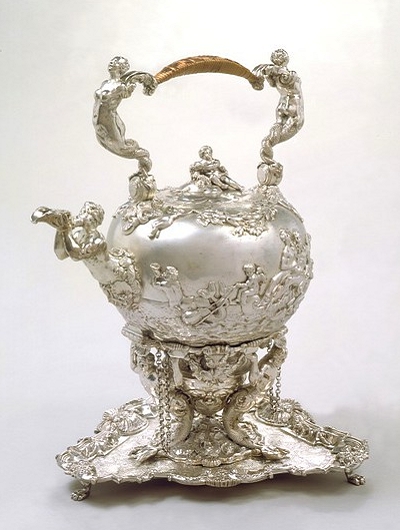 Kettle and Stand, Charles Frederic Kandler, 1730-2. This set is a bold example of the exuberance of the early Rococo decorative style, which still displays elements of the sculptural movement of the Baroque period. The marine theme dominates both the sculptural and the chased decoration. The stand is made up of three mermen, and the handle is formed of mermaids, while the spout is formed of a triton, blowing a conch horn. Each side of the kettle depicts the story of the sea deities Neptune and Amphitrite, the lamp-stand is decorated with marine creatures, and the engraved armorials on the salver are flanked by further depictions of marine gods and goddesses. The Victoria & Albert Museum.Kandler's most important surviving works include;
Kettle and Stand, Charles Frederic Kandler, 1730-2. This set is a bold example of the exuberance of the early Rococo decorative style, which still displays elements of the sculptural movement of the Baroque period. The marine theme dominates both the sculptural and the chased decoration. The stand is made up of three mermen, and the handle is formed of mermaids, while the spout is formed of a triton, blowing a conch horn. Each side of the kettle depicts the story of the sea deities Neptune and Amphitrite, the lamp-stand is decorated with marine creatures, and the engraved armorials on the salver are flanked by further depictions of marine gods and goddesses. The Victoria & Albert Museum.Kandler's most important surviving works include;
- the silver kettle-on-stand (c. 1730-32) at the Victoria and Albert Museum
- the silver wine cistern (1734), in the Hermitage Museum, St. Petersburg
- candlesticks in the Ashmolean Museum, some marked by Paul de Lamerie, and some marked by Kandler.
Patrons - The Norfolk of Arundel / The Cliffords of Chudleigh
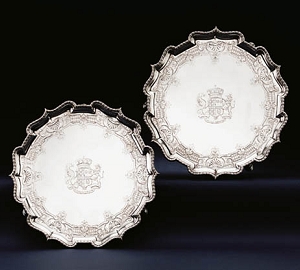 Salver by Charles Frederick Kandler, 1731. Hugh, 3rd Baron Clifford of Chudleigh (1700-1732) was the original purchaser of these salvers from Kandler. These were sold at $ 77300, Christie's on 16 April 1999.The Cliffords of Chudleighwere a leading Catholic family in the eighteenth century and patronized both Charles Kandler and Frederick Kandler extensively between 1730 and 1776.
Salver by Charles Frederick Kandler, 1731. Hugh, 3rd Baron Clifford of Chudleigh (1700-1732) was the original purchaser of these salvers from Kandler. These were sold at $ 77300, Christie's on 16 April 1999.The Cliffords of Chudleighwere a leading Catholic family in the eighteenth century and patronized both Charles Kandler and Frederick Kandler extensively between 1730 and 1776.
Hugh, 3rd Baron Clifford of Chudleigh (1700-1732) was evidently the original purchaser of these salvers from Kandler, as there are traces of the arms of Blount under the arms of Weld on the dexter side of the shield. Hugh, Lord Clifford had married in 1725 Elizabeth, daughter of Edward Blount of Blagden, Devon and sister-in-law of the 9th Duke of Norfolk. Thus the Cliffords were connected to the preeminent Catholic family of England, who were also considerable patrons of Kandler.
At some stage, Kandler became a Roman Catholic, and married into a well-to-do Catholic family. He made huge amounts of silver for the Norfolk family of Arundel, indicating he was favoured by Catholic families.
For a discussion of the Cliffords as patrons of Kandler, see Peter Cameron, "Henry Jernegan, the Kandlers and the Client who Changed his Mind," Silver Society Journal, no. 8, Autumn 1996, p. 499.
The provenance of these salvers is Lord Clifford of Chudleigh who sold these at Christie's, London on 24 March 1965. The arms are those of Clifford impaling those of Weld, for Hugh Charles, 7th Baron Clifford of Chudleigh, who married in 1818 Mary Lucy only daughter of Thomas Weld of Lulworth Castle, Dorset who was afterwards created Cardinal Weld.
These servers were mentioned in Antique Collector, March/April 1943.
Distingusihed Characteristics
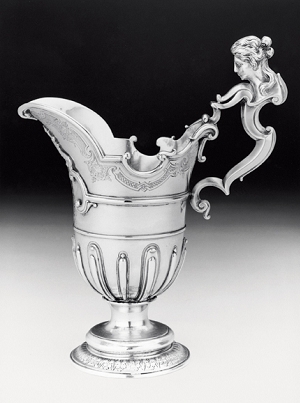 Ewer by Charles Frederick Kandler, 1727. Height: 21.9cm, Weight 674g. The Ashmolean Museum.This Ewer in the Ashmolean Museum was made by Charles Frederick Kandler in 1727 when he registered his first mark into London assay office. So this is the earliest work by the enigmatic goldsmith Kandler (I).
Ewer by Charles Frederick Kandler, 1727. Height: 21.9cm, Weight 674g. The Ashmolean Museum.This Ewer in the Ashmolean Museum was made by Charles Frederick Kandler in 1727 when he registered his first mark into London assay office. So this is the earliest work by the enigmatic goldsmith Kandler (I).
Already this piece exhibited his distingusished characters in the design and the techniques.
The so-called helmet shaped ewer is of French origin and one of the most innovative products of the refugee Huguenot goldsmiths around the turn of the century. Comparable ewers to this were made over a period of forty years and include one of 1702 by Pierre Platel who was the master of Paul de Lamerie and another of 1747 by Samuel Courtauld.
The handle of this ewer appears to be very unique in silver. However there is a very similar design on a Meissen porcelain ewer of c. 1715 in Dresden. This fact suggests that Charles Frederik Kandler was trained at Meissen Porcelain factory in Dresden. There were no records about his origin, birth and apprenticeship in UK.
Charles Frederick Kandler is believed to be a younger brother of Johann Joachim Kaendler, the most famous modeler at Messen Porcelain factory.
Maynard Master was C.F.Kandler ?
The Maynard dish by Paul de Lamerie, London, 1736In the mid-1730s a gifted artist began to work for Paul de Lamerie. His identity remains obscure, but his hand is distinctive. His outstanding skill first appears on the Maynard dish marked in 1736/37 which has
the extraordinary border with figures representing Earth, Air, Fire and Water. The artistic personality executed some of de Lamerie's most ambitious commissions. He is known as the "Maynard Master" after this dish.
This individual was mainly a chaser who would have worked the models for the cast components of these low-relief borders in metal, a medium with which he was at ease. Some elements of a design might call for wax or wood models, and the cast components might be applied to a chased body, but it is in the chased areas of the low relief that the delicate, flowing character of his scenes is most palpable.
Paul de Lamerie seems to have engaged the Maynard Master for many - though not all - of major commissions from about 1736 to about 1745. A series of ewers and dishes, indluding one made for Goldsmith's Company in 1741/42 and another for the 6th Earl of Mountrath in 1742/43 represent the full range of his capabilities.
Recently five drawings of design for silver toilet service as wedding gifts requested by the Augstus III, King of Poland and Elector of Saxony (1696-1763), in 1747 are discovered in the Dresden archives by Maureen Cassidy-Geiger. These drawings are attributed to the Maynard Master who worker for Paul de Lamerie from 1736-47.
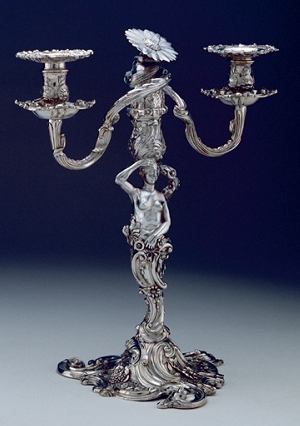 Candelabrums by Charles Frederick Kandler, 1748. The Ashmolean Museum. Height: 40cm, Weight: 4056g. Maker's mark: Sticks: London, sterling standard, 1748-9, Paul de Lamerie. Branches: one London, sterling standard, 1753-4, (Charles) Frederick Kandler.The Dresden drawings show a kinship with some silver marked by Charles Frederick Kandler (I) who arrived in London from his native Dresden in 1727.
Candelabrums by Charles Frederick Kandler, 1748. The Ashmolean Museum. Height: 40cm, Weight: 4056g. Maker's mark: Sticks: London, sterling standard, 1748-9, Paul de Lamerie. Branches: one London, sterling standard, 1753-4, (Charles) Frederick Kandler.The Dresden drawings show a kinship with some silver marked by Charles Frederick Kandler (I) who arrived in London from his native Dresden in 1727.
Paul de Lamerie and Charles Frederick Kandler (I) certainly did business together; a group of candlesticks in the Ashmolean Museum, some marked by de Lamerie, and some marked by Kandler, are testimony to that.
Figure candlesticks first peaked in popularity in the late seventeenth century but the first major attempt to adapt the theme to a rococo interpretation was Juste-Aurele Meissonnier's drawing for a candlestick with a double putto stem, published in Paris in 1728.
This design was followed by the famous double-satyr candelabrum of 1732 by Thomas Germain and finally to be reinterpreted in England by Kandler's Hercules and Iole candelabra of 1737.
The distinctive figural and floral design of these candlesticks place them within the oeuvre of the talented but anonymous modeller - Maynard Master - who was associated with Paul de Lamerie from about 1736 until the late 1740s and who was largely responsible for the artistic character of de Lamerie's later ornamental work. The prominent sunflower motif of the branches is perhaps a reference to the Greek myth of Clytie and Apollo.
Chronological Listing of His Works
Chronological List - Group of Without Barocque Taste
Maker's Mark
Charles Frederick Kandler (I)
On 29 August 1727 Charles Frederick Kandler (I) registered 4 marks. He used the initial "CK" for the Sterling Standard mark (No.1) and "KA" for the Britannia Standard mark (No.2). And also he entered the partnership marks for Sterling standard (No.3) and Britannia standard (No.4) respectively.
The rules on the mark for the Britannia standard which was introduced in 1694 required that the new mark should be composed of the first two letters of the maker's family name.
He probably entered his marks only this time.
Charles Frederick Kandler (II)
On 10 September 1735, the maker's mark (No.5) "FK" with star below was registered by Charles Frederick Kandler (II). It was the first time for the Kandler to use the initials "FK" and this mark was restruck in the same entry as the marks (No.6) and (No.7). In the same year the premises in Jermyn Street was taken over by Charles Frederick Kandler from his elder brother Johann Joachim Kandler, the famous modeler at the Meissen Factory.
The last "FK" mark (No.11) was registered in 1776.
Charles Frederick Kandler (III)
On 12 Novemver 1778 Charles Frederick Kandler (III) registered his mark (No.12) using the initials "CK" which was only usued by Kandler (I) for his Sterling standard mark (No.1) registered in 1727.
|
No. 1 (29 August1727) |
No. No. 2 (29 August 1727 ?) | |||||
|
No. 3 (29 August 1727) |
No. 4 (29 August 1727) | |||||
|
No. 5 (unregistered, about 1730) |
No. 6 (10 September 1735) | |||||
|
No. 7 (25 June 1739) |
No. 8 (un-dated) | |||||
|
No. 9 (unregistered, about 1751) |
No. 10 (24 June 1758) | |||||
|
No.11 (unregistered, 1776) |
No.12 (12 November 1778) | |||||
Inland Revenue Records
The distinction of the varying Christian names is repeated in the entries of various apprentices to Kandler in the indexe to the apprentices of Great Britain extracted from the Inland Revenue books at the Public Record Office.
In 1735 Charles Kandler, goldsmith of St. James's, appears as master of Ralph Wilberforce and James Rigby.
In 1743 Charles Frederick Kandler, also goldsmith, St. James's, Westminster, is listed as master of William Moody (q.v.).
In 1748 Frederick Kandler of St. James, Westminster, silversmith, appears as master of William Reynolds (q.v.) again.
In 1760 Frederick Kandler of St. James, Westminster, silversmith, appears as master of Peter Rooney again.
In 1773 Frederick Kandler, plateworker, Jermyn Street, appears in the Parl. Report list.
Charles Frederick Kandler (II), active about 1735-1778 in London
In 1735 another goldsmith named Charles Frederick Kandler (II) (1735-1778), possibly a cousin or nephew of Kandler (I) was entered in the register, located at the same address.
He continued to use the initials "FK" as his mark so he is mentioned as "Frederick Kandler". The first "FK" marke was registered in 1735 and the last was in 1776.
He had good skills but never reached the level of Kandler (I) and his designs were more plain and lack of Baroque taiste which is one of the distingusished characteristics of Kandler (I).
However there were some very high quality silverware by him which shows his fairy good skills.
Distinguished Characteristics
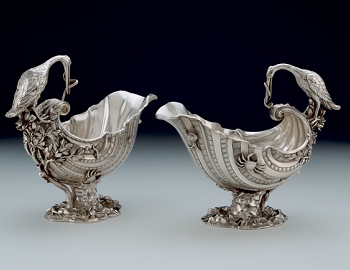 Sauceboats marked by the initials FK - Charles Frederick Kandler (II), 1737. Width: 21.2cm, Weight: 799g. The Ashmolean Museum.These sauceboats in 1737 represent the quintessence of rococo design.
Sauceboats marked by the initials FK - Charles Frederick Kandler (II), 1737. Width: 21.2cm, Weight: 799g. The Ashmolean Museum.These sauceboats in 1737 represent the quintessence of rococo design.
Although no specific source for the design can be found, there is a clear relationship with a series of vessels, both in silver and porcelain, produced by Nicholas Sprimontand Paul Crespin. Sprimont's 1742 crayfish salts in the Royal Collection are particularly close in conception.
The naturalistic rendering of the shells on both boat and salt is a feature that suggests an awareness of developments in French design. Particulary the marine theme would derived from Juste-Aulele Meissonier's tureen in 1736.
On the otherhand the heron and snake motif is not uncommon in English silver designs. It must be derived from the famous Heron figures modeled by Johann Jaochim Kandlerin 1732 for the Japanese Project.
These sauceboat beards "FK" mark registered by Kandler (II) in 1735. So thiese were one of Kandler (II)'s earliest works.
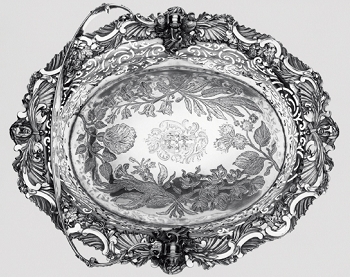 Basket marked by the initials FK - Charles Frederick Kandler (II), 1738. Length: 37.6cm, Width: 30.8cm, Height: 25.5cm. Weight: 2101g. The AshmThe decorative scheme for this basket in 1738 is unique, particularly the flat-chased floral design surrounding the coat of arms, perhaps derived from printed fabric or wallpaper, and the cast ornament combining the shells, foliage and burnished scrolls.
Basket marked by the initials FK - Charles Frederick Kandler (II), 1738. Length: 37.6cm, Width: 30.8cm, Height: 25.5cm. Weight: 2101g. The AshmThe decorative scheme for this basket in 1738 is unique, particularly the flat-chased floral design surrounding the coat of arms, perhaps derived from printed fabric or wallpaper, and the cast ornament combining the shells, foliage and burnished scrolls.
In a more general sense, the cast feet and apron of the basket represent a new trend in design, which succeeded the pierced rim foot of earlier baskets. The Ceres masks (goddess of agriculture) flanked by crossed wheat ears allude to the basket's function as a bread basket.
This basket shows Kandler(II)'s strong characteristics clearly distinguished from Kandler (I).
Chronological List of His Works
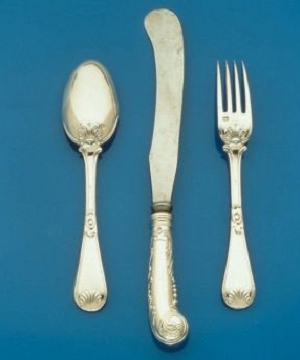 Table Service by Charles Frederick Kandler, 1750. The Museum of Fine Art, Boston. Table Service by Charles Frederick Kandler, 1750. The Museum of Fine Art, Boston. | 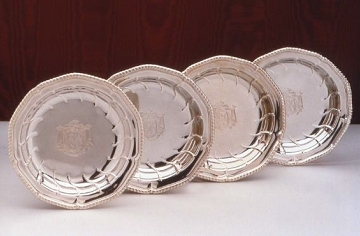 Dish by Charles Frederick Kandler, 1752. Diameters: 23.8cm. The Museum of Fine Arts, Boston. Dish by Charles Frederick Kandler, 1752. Diameters: 23.8cm. The Museum of Fine Arts, Boston. |
|
|
Charles Frederick Kandler III (active 1775 until 1793)
 1778/11/12 registeredOn 12 November 1778 his mark, "CK" in the bullnose square, entered as plateworker. And he entered a small similar mark on the same day. Address: 100 Jermyn Street.
1778/11/12 registeredOn 12 November 1778 his mark, "CK" in the bullnose square, entered as plateworker. And he entered a small similar mark on the same day. Address: 100 Jermyn Street.
He might use the unregistered mark No. 11 "FK".
He has certainly some relationship with Charles Frederick Kandler (I), presumably a grandson.
Heal recorded him as a plateworker untill 1793.
 Top
Top Site Map
Site Map References
References About Me
About Me